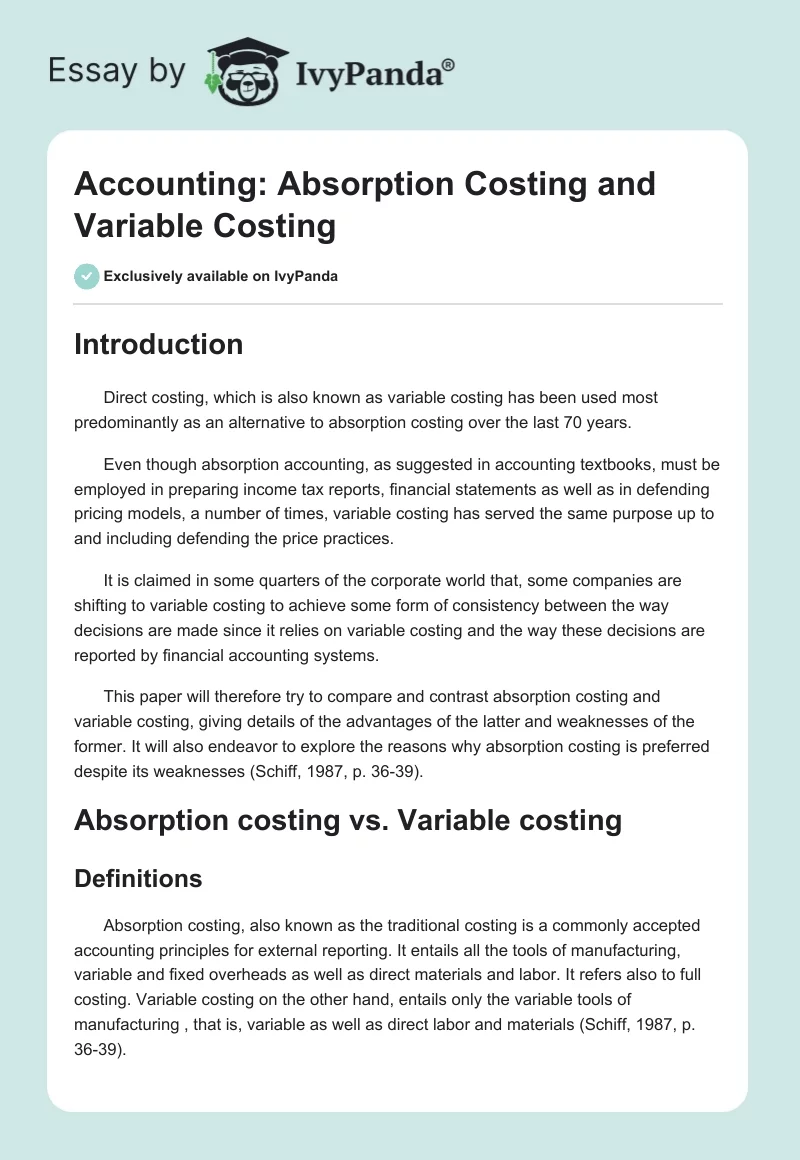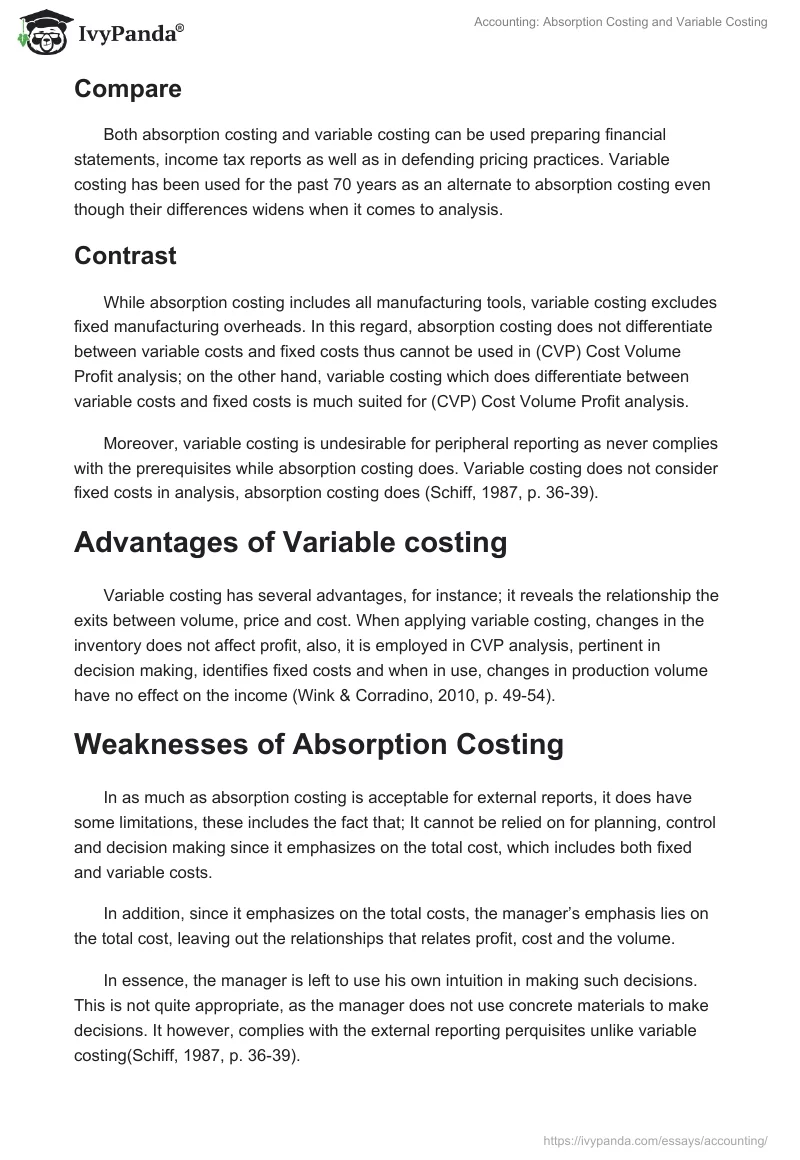Introduction
Direct costing, which is also known as variable costing has been used most predominantly as an alternative to absorption costing over the last 70 years.
Even though absorption accounting, as suggested in accounting textbooks, must be employed in preparing income tax reports, financial statements as well as in defending pricing models, a number of times, variable costing has served the same purpose up to and including defending the price practices.
It is claimed in some quarters of the corporate world that, some companies are shifting to variable costing to achieve some form of consistency between the way decisions are made since it relies on variable costing and the way these decisions are reported by financial accounting systems.
This paper will therefore try to compare and contrast absorption costing and variable costing, giving details of the advantages of the latter and weaknesses of the former. It will also endeavor to explore the reasons why absorption costing is preferred despite its weaknesses (Schiff, 1987, p. 36-39).
Absorption costing vs. Variable costing
Definitions
Absorption costing, also known as the traditional costing is a commonly accepted accounting principles for external reporting. It entails all the tools of manufacturing, variable and fixed overheads as well as direct materials and labor. It refers also to full costing. Variable costing on the other hand, entails only the variable tools of manufacturing , that is, variable as well as direct labor and materials (Schiff, 1987, p. 36-39).
Compare
Both absorption costing and variable costing can be used preparing financial statements, income tax reports as well as in defending pricing practices. Variable costing has been used for the past 70 years as an alternate to absorption costing even though their differences widens when it comes to analysis.
Contrast
While absorption costing includes all manufacturing tools, variable costing excludes fixed manufacturing overheads. In this regard, absorption costing does not differentiate between variable costs and fixed costs thus cannot be used in (CVP) Cost Volume Profit analysis; on the other hand, variable costing which does differentiate between variable costs and fixed costs is much suited for (CVP) Cost Volume Profit analysis.
Moreover, variable costing is undesirable for peripheral reporting as never complies with the prerequisites while absorption costing does. Variable costing does not consider fixed costs in analysis, absorption costing does (Schiff, 1987, p. 36-39).
Advantages of Variable costing
Variable costing has several advantages, for instance; it reveals the relationship the exits between volume, price and cost. When applying variable costing, changes in the inventory does not affect profit, also, it is employed in CVP analysis, pertinent in decision making, identifies fixed costs and when in use, changes in production volume have no effect on the income (Wink & Corradino, 2010, p. 49-54).
Weaknesses of Absorption Costing
In as much as absorption costing is acceptable for external reports, it does have some limitations, these includes the fact that; It cannot be relied on for planning, control and decision making since it emphasizes on the total cost, which includes both fixed and variable costs.
In addition, since it emphasizes on the total costs, the manager’s emphasis lies on the total cost, leaving out the relationships that relates profit, cost and the volume.
In essence, the manager is left to use his own intuition in making such decisions. This is not quite appropriate, as the manager does not use concrete materials to make decisions. It however, complies with the external reporting perquisites unlike variable costing(Schiff, 1987, p. 36-39).
Why Absorption Costing is used despite its weaknesses
In comparison to variable costing, absorption costing seems to have much more weaknesses, but as it turns out, it is still the more preferred of the two.
This is mainly because, according to accounting books, absorption costing fully complies with the requirements for external reporting, something that does not go well with variable costing. It therefore remains that absorption costing is used since its presentations can be reported externally (Wink & Corradino, 2010, p. 49-54).
As entailed in the accounting principles, which regulates the requirements for external reporting, both fixed and variable costs are required for incorporation in the inventory, mainly to prepare the inventory for application as is intended.
This usually incorporates an acceptable proportion of manufacturing overhead incurred as the inventory is manufactured. Furthermore, variable costing treats as period costs, all fixed manufacturing overhead (Schiff, 1987, p. 36-39).
Conclusion
Absorption costing encompasses all the tools of manufacturing while variable costing ignores fixed costs. Variable costing ignores fixed costs in analysis although it is useful for Cost Volume Profit analysis. Absorption costing on the other hand is not utilized in analysis of Cost Volume Profit hence, does not give their interrelationship (Schiff, 1987, p. 36-39).
In as much as variable costing boast of several advantages such as its usefulness in planning, control and decision-making, among others, it does not comply with the requirements for external reporting and therefore remains as an alternative use for absorption costing, which is the most preferred and acceptable.
Absorption costing also has a number of weaknesses that includes its inability to be used for CVP analysis, among others. It is therefore imperative to note that the two costing methods are important and should be applied where possible, with clear regards to their importance (Wink & Corradino, 2010, p. 49-54).
Reference
Schiff, M. (1987). Variable Costing: A Closer Look [2]. Management Accounting, 68(8), 36. Retrieved from ABI/INFORM Global. (Document ID: 652509).
Wink, G., & Corradino, L. (2010). INCOME INFLATION: ABSORPTION COSTING VS. VARIABLE. Journal of the International Academy for Case Studies: Special Issue Number 1,49-54. Retrieved from ABI/INFORM Global. (Document ID: 2243561401).


